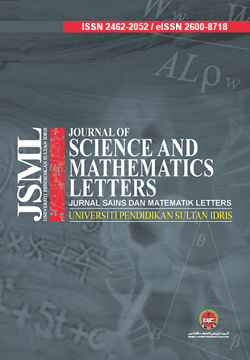Ultrasonic Assisted Extraction and Gas Chromatography-Tandem Mass Spectroscopy (GC-MS/MS) Analysis of Extracts from Four Cassia Species
DOI:
https://doi.org/10.37134/jsml.vol8.2.1.2020Keywords:
Cassia, GC-MS/MS, phytoconstituents, extraction, fatty acidAbstract
Ultrasonic assisted extraction (UAE) process increases the rate of extraction, the yield of extracted components and reduces extraction time. The high sensitivity of GC-MS/MS provides reliable identification of phytoconstituents present in a plant extract. This research is to develop an easy and effective method for the extraction and analysis of phytochemicals in C. singueana, C. sieberiana, C. tora and C. occidentalis using UAE and GC-MS/MS techniques. The crude extracts obtained from the four Cassia species under UAE conditions of 50 mins extraction time, 50 oC extraction temperature and 20 mL/g solvent to sample ratio were analyzed using GC-MS/MS. Thirty-four compounds were identified by comparison of their mass spectra with those in the National Institute of Standards and Technology library, requiring at least 80% similarity. These compounds comprise fatty acids, fatty alcohol, carboxylic acid, long-chain alkanes, diterpenes, triterpenes, sterols and anthraquinones. n-Hexadecanoic acid and phytol were identified in all the Cassia species while anthraquinone was detected only from the methanol extracts of C. tora and C. occidentalis. The bioactivities reported in the literature for these compounds corroborate with the phytoconstituents identified in these plants and support the ethnomedicinal uses of these Cassia species.
Downloads
References
Cai, Y.Z., Mei, S., Jie, X., Luo, Q., Corke, H. (2006). Structure-radical scavenging activity relationships of phenolic compounds from traditional Chinese medicinal plants. Life Sciences, 78, 2872-2888.
Camila, C.M.P.S., Mirian, S.S., Vanine, G.M., Luciana, M.C., Antonia, A.C.A., Guilherime, A.L.O., Jessica P.C., Damiao, P.S., Rivelilson, M.F., Reinaldo, N.A. (2013). Antinociceptive and antioxidant activities of phytol In vivo and In vitro model. Neuroscience Journal, 1-10.
Dominguez, G.H., González, M.M J. (2018). Water Extraction of Bioactive Compounds: From Plants to Drug Development, Elsevier, p.1-50.
Favour, O., Madubuike, G.K. (2015). Studies on anti-diarrheal activity of Cassia sieberiana in mice. Journal of Advances in Biology & Biotechnology, 3, 139-144.
Gati, K.P., Ratnasekhar, C., Mohana, K.R.M., Vipin, M.V., Raisuddin, S., Mukul, D. (2015). Activity-guided chemo toxic profiling of Cassia occidentalis (CO) seeds: Detection of toxic compounds in body fluids of CO-exposed patients and experimental rats. Chemical Research in Toxicology, 28(6), 1120-1132.
Gideon, K.M., Samuel, O.O., Maxwell, I.E. (2015). Antioxidant and hepatoprotective activity of methanolic extract of Cassia sieberiana leaves in carbon tetrachloride-induced hepatotoxicity in rats. Journal of Advances in Medical and Pharmaceutical Sciences, 2, 1-9.
Guardia, M., Armenta, S. (2011). Green Analytical Chemistry, volume 57: theory and practice, Comprehensive Analytical Chemistry, Elsevier.
Harshai, A.D., Sanjivani, R.B. (2013). Recent advances in the phytochemistry of some medicinally important Cassia species: A review. International Journal of Pharma and Bio Sciences, 2, 60-78.
Ibrahim, M.A., Islam, M.S. (2014). Anti-diabetic effects of the acetone fraction of Senna singueana stem barkinatype2diabetesratmodel. Journal of Ethnopharmacology, 153, 392-399.
Ifeanyi, I.M., Ode, O.J. (2012). In vitro and in vivo antioxidant potential of the methanolic extract of Cassia singueana Delile (Fabaceae) Lock leaves. Comparative Clinical Pathology, 21, 1565-1569.
Jibril, S., Norazah, B., Sirat, H.M., Wahab, R.A., Mahat, N.A., Nahar, L., Sarker, S.D. (2018). Application of Box Behnken design for Ultrasonic-Assisted extraction and recycling preparative HPLC for isolation of anthraquinones from Cassia singueana. Phytochemical Analysis, 30(1), 101-109.
Jibril, S., Sirat, H.M., Basar, N. (2017). A new stilbene from the root of Cassia sieberiana D.C. (Fabaceae). Natural Product Communications, 12, 1095-1098.
Jibril, S., Sirat, H.M.. Basar, N. (2017). Bioassay-guided isolation of antioxidants and α-glucosidase inhibitors from the root of Cassia sieberiana D.C. (Fabaceae). Records of Natural Products, 11, 406-410.
Khomendra, K.S., Mithun, R., Manabendra, D., Atul, K., Vinod, K.V. (2014). Phytochemical and biological potential of Cassia tora Linn. European Journal of Medicinal Plants, 4, 946-963.
Lifset, H.C. (2018). The impact of bioactive phytosterol, stigmasterol, on cholesterol elimination pathway in mice. Master's Thesis, University of Kentucky.
Lijun, W., Curtis, L.W. (2006). Recent advances in the extraction of nutraceuticals from plants. Food Science & Technology Food Science & Technology, 17, 300-312.
Mohammed, A.I., Neil, A.K., ShahidulIIslam, M. (2013). In vitro antioxidative activity and GC-MS analysis of various solvent extracts of Cassia singueana parts. Acta Poloniae Pharmaceutic in Drug Research, 70(4), 709-719.
Navpreet, K., Jasmine, C., Akash, J., Lalit, K. (2011). Stigmasterol: A comprehensive review. International Journal of Pharmaceutical Sciences and Research, 2, 2259-2265.
Ode, O.J., Asuzu. I.U. (2014). Luteolin isolates from the methanol extract identified as the single-carbon compound responsible for broad antiulcer activities of Cassia singueana Leaves. IOSR Journal Of Pharmacy, 4. 17-23.
Onakpa, M.M., Ode, O.J. (2010). Evaluation of Cassia singueana extract on stomach HCl production and gastric emptying in rats. International Journal of Applied Biology and Pharmaceutical Technology, 1, 1352-1358.
Schmelzer, G.H., Gurib-Fakim, A. (2008). Plant Resource of Tropical Africa 11 (1) Medicinal Plants 1. PROTA Foundation, Wageningen, Netherlands, Backhuys Publishers.
Smita, J., Patil, U.K. (2010). Phytochemical and pharmacological profile of Cassia tora Linn: An overview. Indian Journal of Natural Products and Resources, 1, 430-437.
Toma, M.V., Paniwnyk, M.I., Mason, T.J. (2001). An overview of the ultrasonically assisted extraction of bioactive principles from herbs. Ultrasonics Sonochemistry, 8, 303-313.
Vedpriya, A., Yadav, J.P. (2010). Antioxidant activity and total phenolics in leaves extracts of Cassia tora L. Pharmacologyonline, 2, 1030-1036.
Yadav, J.P., Vedpriya, A., Sanjay, Y., Manju, P., Sandeep, K., Seema, D. (2010). Cassia occidentalis L.: A review on its ethnobotany, phytochemical and pharmacological profile. Fitoterapia, 81, 223-230.
Zih-Rou, H., Yin-Ku, L., Jia-You, F. (2009). Biological and pharmacological activities of squalene and related compounds: potential uses in cosmetic dermatology. Molecules, 14, 540-554.





